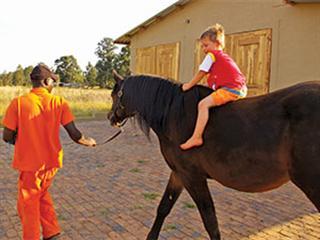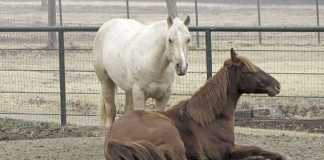
I often get emails asking me how to bring a horse back into work after an illness or injury. My philosophy is simple. Think of what animals would do in the wild. Then use common sense and consult a professional. Let’s start with the basics. In the wild, horses move about most of the time, covering on average about 30km a day. Unfortunately, our horses are stabled for most of their lives, or at least in the evenings. This means that they need additional exercise to prevent them from gaining unnecessary weight and becoming bored.
It’s very dangerous to keep a horse stabled for days. This treatment is acceptable only if the horse is ill or has an injury that requires it to be kept quiet. Even if the animal is ill, it’s important to take it out on a lead to grass a little or just to walk a short distance. If your horse stands in a stable for any length of time, its circulation will slow down and toxins will begin accumulating in its body, putting it under unnecessary stress. Remove all concentrates, and feed your horse nothing but good quality hay. In fact, your horse should always have access to roughage, unless your vet has advised otherwise.
Assessing your horse
When you do decide to bring a horse back into work after a time off, whether it was due to illness or a holiday, it’s essential that it knows what you expect it to do. Getting a horse fit also takes commitment on your part. First assess the animal, asking yourself:
- Is it suitable for the job?
- How unfit is it?
- How much time do you have?
- Is the horse completely sound?
- Is it in good health, and not too overweight, underweight or ill?
- Remember that when you start increasing your horse’s workload, you’ll need to increase its energy intake – that is, its concentrate (hard feed).
Getting started
Fitness is the ability to carry out strenuous work and recover from the effort with relative ease. Walking is a perfect place to start. Begin with a daily 20-minute walk in hand for six days. Then give one day off. The following week, saddle up and walk for 20 minutes a day for six days, and give one day off. Every day after the workout, check the horse’s legs for heat or swelling. This will serve as the perfect guideline to the response to work.
In week three, increase the walking time to 30 minutes. Do this week by week until you’re walking for an hour. Then increase the workload by including two-minute bursts of trot. By the time three months have passed, you should be doing 10 bursts of trot. This is the best way to start any horse. Within three months, your horse should be fit enough to do canter work.
Contact Kim Dyson on 082 888 6511 or at [email protected]. Please state ‘Horse therapy’ in the subject line of your email.













